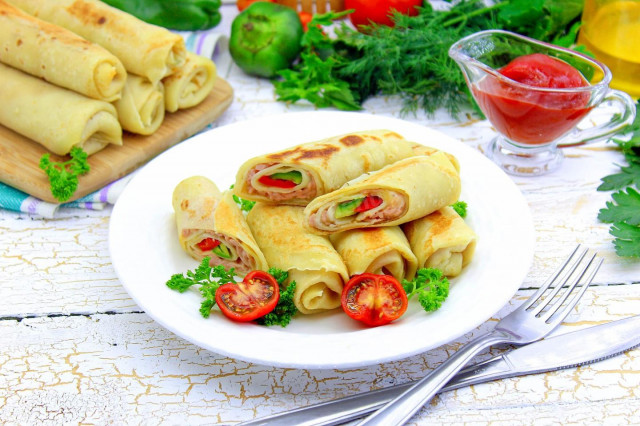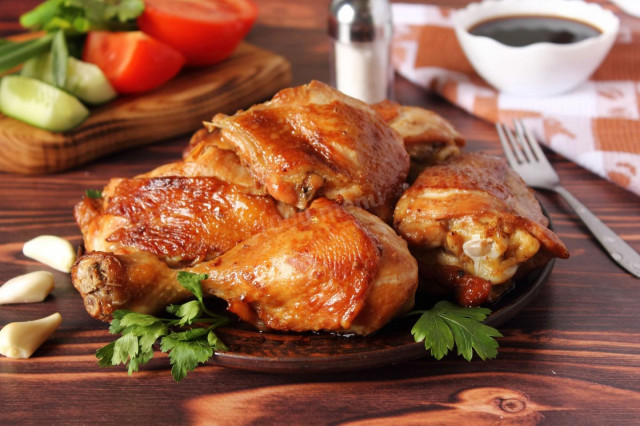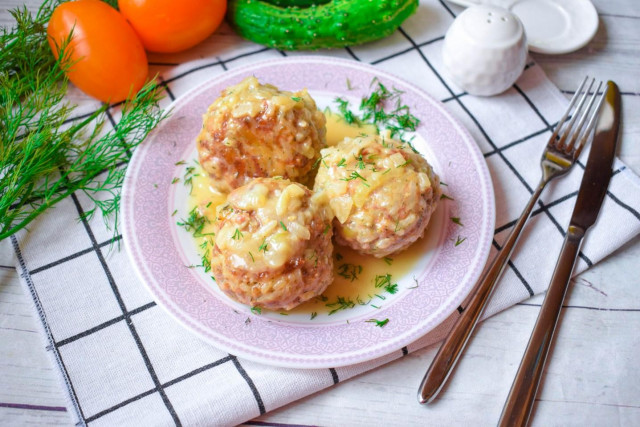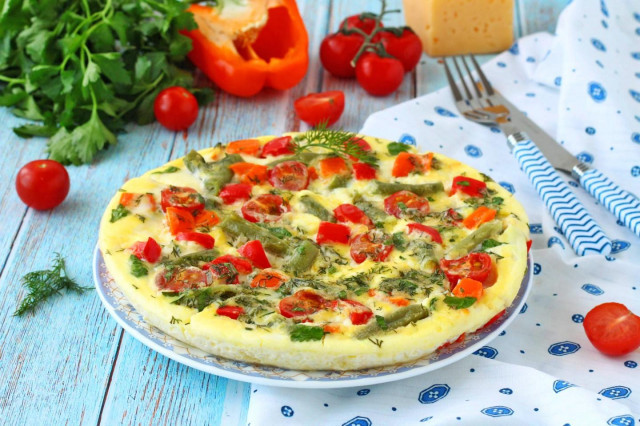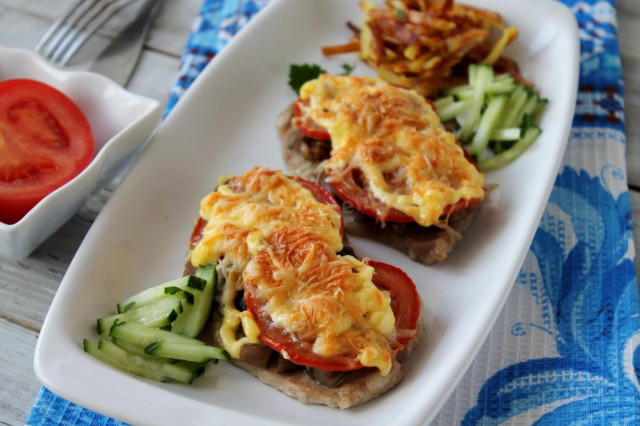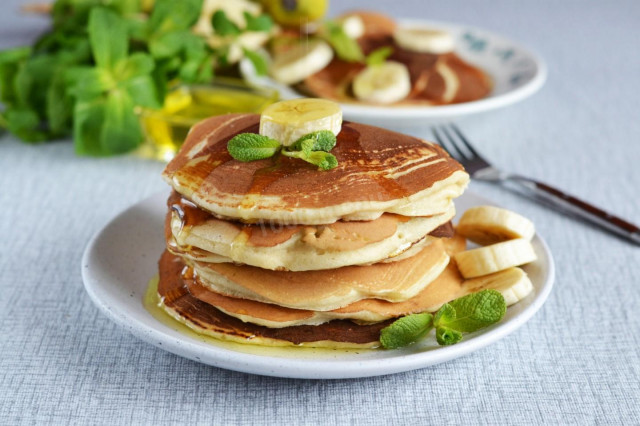Composition / ingredients
Step-by-step cooking
Step 1:

How to make pancakes with sausage and cheese? Prepare all the necessary ingredients. Milk, water and eggs should be at room temperature to make the dough successful. Therefore, take them out of the refrigerator in advance — 1-2 hours in advance.
Step 2:
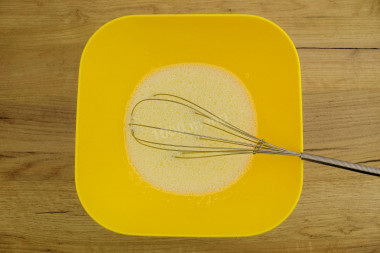
Wash the eggs with soap. In a deep bowl, whisk the eggs with sugar and salt. It is not necessary to beat up to foam. Then add the milk and mix until smooth.
Step 3:
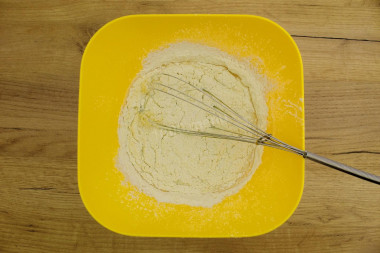
Sift the flour so that it is saturated with oxygen and the pancakes turn out to be airy. Pour more than half of the flour into a deep bowl, add soda there, mix. Make a recess in the flour and pour the egg-milk liquid component of the dough into it. Stir with a whisk until smooth. Add the rest of the flour in small portions until it becomes difficult to mix.
Step 4:

You should get a homogeneous thick dough. Dilute it with water until you get the desired consistency. This means that you may take more or less flour than indicated in the recipe - keep this in mind.
Step 5:
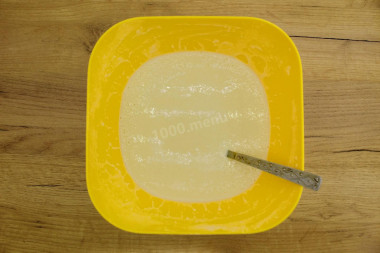
The thickness of the dough should turn out like heavy cream. Leave the dough to infuse for 10-15 minutes. If the dough is too thin, add a little flour until the desired consistency is obtained.
Step 6:

Prepare the filling. Choose a cheese that melts well when heated. Any boiled sausage, which will be convenient to grate on a grater. You can not use Bulgarian pepper, but leave only sausage and cheese for the filling, but with a vegetable additive, the taste turns out to be more interesting.
Step 7:
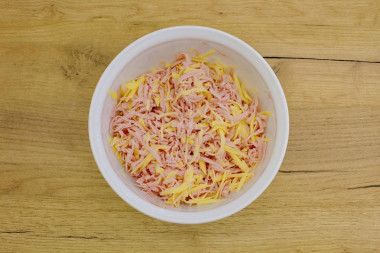
Grate the cheese and sausage on a coarse grater. So the filling will become more tender and homogeneous.
Step 8:

Wash the bell pepper, remove the stalk, cut, peel the seeds and cut along the whole pepper into strips. There should be 24 pieces in total.
Step 9:

Take a frying pan with a diameter of 22 cm - a pancake pan or one in which it is convenient for you to bake pancakes. Preheat the frying pan to a hot state. Brush with vegetable oil. Pour a little dough on it and, turning and tilting it, spread it all over the bottom. Bake pancakes on medium heat on one side until golden brown, do not brown the other side too much. Lubricate the pan with oil if necessary, if they begin to stick to the pan.
Step 10:
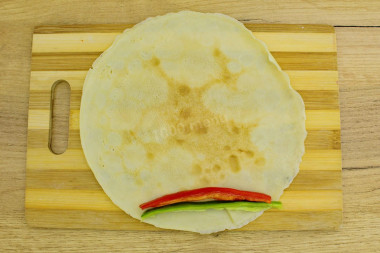
I got 14 pancakes. Proceed to filling the pancakes with stuffing. Put the pancake with the more fried side up. Put 2 pepper straws on the edge.
Step 11:

Wrap the pepper in a pancake a little, then put about a tablespoon of the filling to the middle of the pancake, wrap the edges, as if covering it and press a little.
Step 12:
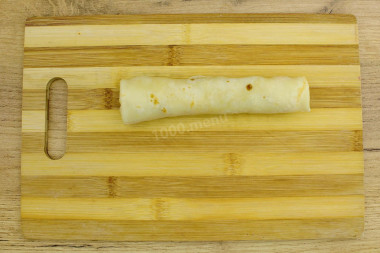
Carefully tightly twist the pancake with the filling.
Step 13:
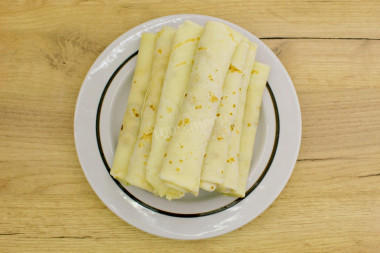
Roll up all the pancakes in this way.
Step 14:

Then fry them in butter on both sides over medium heat until golden brown. At the same time, the filling should warm up so that the cheese melts.
Serve these pancakes for breakfast or for a snack during the day. Pepper in the filling can be replaced according to your taste with pieces of fresh or dried tomatoes, herbs, mushrooms. In general, show imagination and get pancakes with a variety of fillings.
If you cook pancakes in advance, store them in a container under a lid, in a bag, or wrap with cling film so that they do not chafe and dry. And fry or reheat immediately before serving.
Instead of sugar, you can use a sweetener that is not afraid of heat treatment.
Use oil with a high smoking temperature for the dough. Any oils are useful only until a certain temperature is reached - the point of smoking, at which the oil begins to burn and toxic substances, including carcinogens, are formed in it.
Unrefined oils, with rare exceptions, have a low smoking point. There are a lot of unfiltered organic particles in them, which quickly begin to burn.
Refined oils are more resistant to heating, and their smoking point is higher. If you are going to cook food in the oven, on a frying pan or grill, make sure that you use oil with a high smoking point. The most common of the oils with a high smoking point: refined varieties of sunflower, olive and grape.
Be prepared for the fact that flour may need more or less than indicated in the recipe. Focus not on the amount of flour, but on the desired consistency of the dough. To avoid mistakes, read about flour and its properties!
Caloric content of products possible in the composition of the dish
- Whole cow's milk - 68 kcal/100g
- Milk 3.5% fat content - 64 kcal/100g
- Milk 3.2% fat content - 60 kcal/100g
- Milk 1.5% fat content - 47 kcal/100g
- Concentrated milk 7.5% fat content - 140 kcal/100g
- Milk 2.5% fat content - 54 kcal/100g
- Sweet pepper - 27 kcal/100g
- Dutch cheese - 352 kcal/100g
- Swiss cheese - 335 kcal/100g
- Russian cheese - 366 kcal/100g
- Kostroma cheese - 345 kcal/100g
- Yaroslavsky cheese - 361 kcal/100g
- Altai cheese 50% fat content - 356 kcal/100g
- Soviet cheese - 400 kcal/100g
- Cheese "steppe" - 362 kcal/100g
- Uglich cheese - 347 kcal/100g
- Poshekhonsky cheese - 350 kcal/100g
- Lambert cheese - 377 kcal/100g
- Appnzeller cheese with 50% fat content - 400 kcal/100g
- Chester cheese with 50% fat content - 363 kcal/100g
- Edamer cheese with 40% fat content - 340 kcal/100g
- Cheese with mushrooms of 50% fat content - 395 kcal/100g
- Emmental cheese with 45% fat content - 420 kcal/100g
- Gouda cheese with 45% fat content - 356 kcal/100g
- Aiadeus cheese - 364 kcal/100g
- Dom blanc cheese (semi-hard) - 360 kcal/100g
- Lo spalmino cheese - 61 kcal/100g
- Cheese "etorki" (sheep, hard) - 401 kcal/100g
- White cheese - 100 kcal/100g
- Fat yellow cheese - 260 kcal/100g
- Altai cheese - 355 kcal/100g
- Kaunas cheese - 355 kcal/100g
- Latvian cheese - 316 kcal/100g
- Limburger cheese - 327 kcal/100g
- Lithuanian cheese - 250 kcal/100g
- Lake cheese - 350 kcal/100g
- Gruyere cheese - 396 kcal/100g
- Granulated sugar - 398 kcal/100g
- Sugar - 398 kcal/100g
- Butter 82% - 734 kcal/100g
- Amateur unsalted butter - 709 kcal/100g
- Unsalted peasant butter - 661 kcal/100g
- Peasant salted butter - 652 kcal/100g
- Melted butter - 869 kcal/100g
- Salt - 0 kcal/100g
- Sausage "amateur" - 291 kcal/100g
- Sausage "Ukrainian" - 404 kcal/100g
- Diabetic sausage - 254 kcal/100g
- Sausage "doctor" - 197 kcal/100g
- Diet sausage - 170 kcal/100g
- Sausage "milk" - 252 kcal/100g
- Water - 0 kcal/100g
- Wheat flour - 325 kcal/100g
- Sunflower oil - 898 kcal/100g
- Refined sunflower oil - 899 kcal/100g
- Baking soda - 0 kcal/100g
- Chicken egg - 80 kcal/100g

